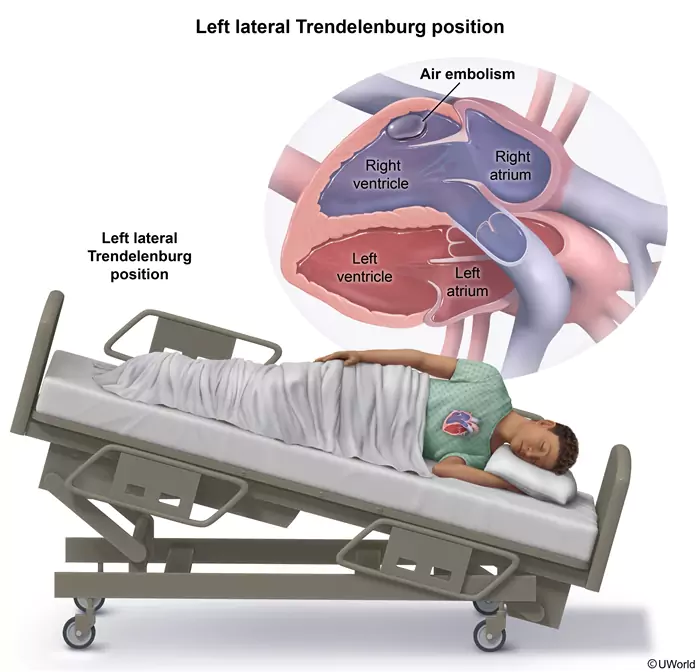A nurse caring for a client with a central venous catheter (CVC) enters the client's room and notes that the CVC is dislodged and lying in the client's bed linens. The client appears cyanotic and is tachypneic and diaphoretic. Which of the following actions by the nurse are appropriate? Select all that apply.
Below is the code for an example image modal link
Flashcards
/* -- Un-comment the code below to show all parts of question -- */
| A. Administer oxygen via non-rebreather mask | ||
| B. Apply an occlusive dressing over the insertion site | ||
| C. Assist the client to high Fowler position | ||
| D. Monitor vital signs and respiratory effort | ||
| E. Notify the health care provider |
Air embolism is a rare but life-threatening complication of central venous catheter (CVC) placement in which air enters the bloodstream. This air displaces blood in the pulmonary vessels, which prevents oxygenation of blood by the lungs. Air embolism may occur after CVC removal, as air can enter the bloodstream via the open, large-bore insertion site.
Clients with air embolism can rapidly develop respiratory distress leading to cardiopulmonary collapse. Nurses caring for clients with symptoms of air embolism (eg, hypoxemia, dyspnea, sense of impending doom) after CVC removal or dislodgement should perform these actions:
- Apply an occlusive dressing to the insertion site to prevent entry of additional air into the bloodstream (Option 2)
- Administer 100% oxygen via non-rebreather mask to improve oxygenation (Option 1)
- Position the client in left lateral Trendelenburg position to promote venous air pooling in the heart apex rather than the lung capillary beds
- Continuously monitor vital signs and client respiratory effort to identify changes in client status (Option 4)
- Notify the health care provider immediately (Option 5)
(Option 3) High Fowler position may worsen respiratory distress caused by air embolism by promoting displacement of venous air emboli into pulmonary circulation.
Educational objective:
Air embolism is a rare, life-threatening complication of central venous catheter (CVC) insertion/removal. Nurses caring for clients with symptoms of air embolism after CVC removal should apply an occlusive dressing to the site, administer oxygen, position the client in left lateral Trendelenburg position, monitor client status, and immediately notify the health care provider.
Lecture References :
- Fundamentals - Positioning






